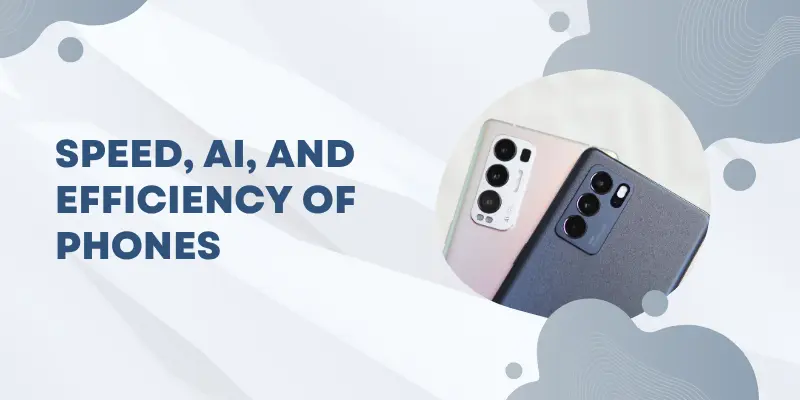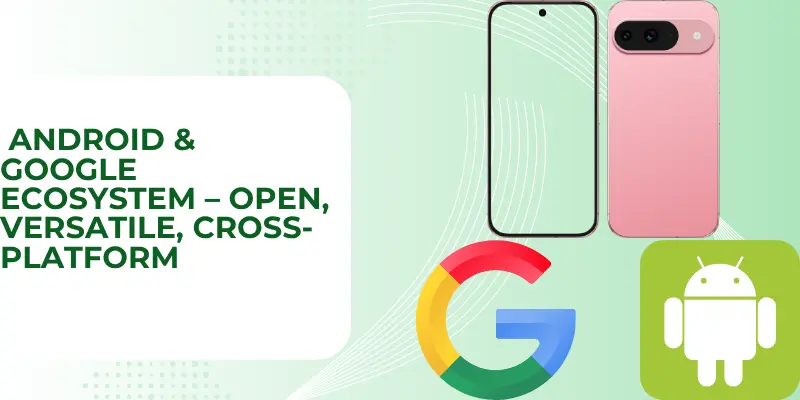iPhone vs Android Comparison: Which Is Truly Better in 2025?
Published: 04 Jul 2025
Choosing between iPhone and Android isn’t easy. Both dominate the smartphone world but offer very different experiences. iPhone is known for its smooth interface, privacy, and premium ecosystem. Android wins with flexibility, customization, and more hardware options. Whether you care about camera quality, privacy, budget, or features — this guide will help you pick the right one. Ready to find out which suits you best? Let’s dive in!
1. Introduction: iPhone vs Android – The Ultimate Battle
In the world of smartphones, iPhone vs Android is the ultimate showdown. Both dominate the market, offering powerful features, sleek designs, and unique ecosystems. But the question remains — which one is better for you?
iPhones run on Apple’s iOS, famous for its simplicity, security, and smooth ecosystem. On the other hand, Android, powered by Google, offers more flexibility, customization, and a wide variety of devices.
This comparison isn’t just about phones — it’s about user experience, privacy, apps, AI features, and how seamlessly your devices work together. Whether you’re a student, professional, gamer, or content creator, choosing the right platform matters.
Ready to discover which one wins in 2024? Let’s dive in!
2. Hardware Differences: Build, Variety, and Customization
When it comes to hardware, the iPhone vs Android battle is clear-cut but competitive.
iPhone Hardware: Premium but Limited
- Apple releases only a few models each year, focusing on premium design and materials.
- Expect glass, stainless steel, titanium, and precise craftsmanship.
- Every iPhone offers a consistent build, optimized for performance, durability, and longevity.
- Limited size and style options — you either love it or don’t.
Android Hardware: Endless Variety, Total Freedom
- Android powers devices from countless brands like Samsung, Google, OnePlus, Xiaomi, Motorola, and more.
- From ultra-premium models like Samsung Galaxy S25 Ultra to affordable phones like Pixel 9a, there’s something for every budget.
- Offers foldables (Galaxy Z Fold, Razr), gaming phones (ASUS ROG Phone), and rugged phones for harsh environments.
- Android phones come in multiple designs, materials, sizes, and innovative forms.
Customization Edge
- Android wins when it comes to hardware customization — different screen sizes, stylus support, headphone jacks, expandable storage, and unique features like periscope cameras or built-in projectors.
- iPhones keep things simple but polished, prioritizing quality over quantity.
Conclusion:
If you love a consistent, premium feel, iPhone is your pick. If you crave variety, innovation, and customization, Android leads the way.
3. Software & User Interface: Simplicity vs. Flexibility
When it comes to software, iPhone and Android offer two very different worlds — one prioritizes simplicity, the other celebrates flexibility.
iOS: Clean, Simple, and Consistent
- Apple’s iOS is designed for ease of use and uniformity.
- Every iPhone looks and feels the same when it comes to navigation, icons, and settings.
- The interface is clean, intuitive, and beginner-friendly.
- Updates are instant and universal—even older iPhones receive the latest iOS updates simultaneously.
- Perfect for users who want a smooth, reliable, and straightforward experience.
Android: Flexible, Customizable, and Personal
- Android OS lets you customize almost everything—from home screens to icons, widgets, and even the layout.
- Want a completely different look? Use launchers, icon packs, and themes.
- Brands like Samsung (One UI), Google (Pixel UI), and OnePlus (OxygenOS) add unique features and flavors on top of Android.
- More control over how apps behave, multitasking features like split-screen, and gesture customization.
- Updates depend on manufacturers, so some Android phones may get updates slower than iPhones.
Simplicity vs. Freedom — The Verdict
- iPhone offers a polished, no-fuss experience for those who want everything to just work.
- Android offers a playground for tech enthusiasts who love to tweak, modify, and personalize their phone experience.
If you prefer ease and consistency, iPhone wins. If you love freedom and flexibility, Android is the clear choice.
4. Performance & Chipsets: Speed, AI, and Efficiency
When it comes to performance, both iPhone and Android have made huge leaps, but the difference lies in the chips powering them.

Apple’s A-Series & M-Series Chips (iPhone)
- Apple designs its own chips like the A17 Pro and upcoming A18 Bionic.
- Known for blazing-fast performance, smooth gaming, and exceptional graphics.
- Apple’s chips use cutting-edge 3nm technology, offering better speed with less power consumption.
- Unmatched in tasks like 4K video editing, gaming, AI processing, and battery optimization.
- Neural Engine powers advanced AI tasks like live photo edits, voice isolation, and real-time translation effortlessly.
Android’s Chipset Variety: Snapdragon, Tensor & More
- Android phones use chips from different manufacturers:
- Snapdragon 8 Gen 3 (Samsung, OnePlus, Xiaomi): Best for gaming and raw performance.
- Google Tensor G3 (Pixel phones): Focused on AI, voice commands, and smart features, rather than pure power.
- MediaTek Dimensity Series: Found in affordable and mid-range Androids with surprisingly strong efficiency.
- Exynos (Samsung): Used in select regions; performance varies but improving.
- Snapdragon 8 Gen 3 (Samsung, OnePlus, Xiaomi): Best for gaming and raw performance.
- Snapdragon leads in gaming and graphics, while Tensor shines in AI tasks like magic eraser, real-time transcription, and call screening.
AI & Machine Learning Battle
- Apple’s AI focuses on device-based tasks—like smarter photos, Siri enhancements, and privacy-first AI processing.
- Google Pixel’s Tensor chip leads in AI-based photography, real-time language translation, spam call handling, and Magic Editor.
Efficiency & Battery
- Apple chips are more power-efficient, leading to longer battery life despite smaller batteries.
- Android battery life varies—Snapdragon 8 Gen 3 offers strong efficiency, but some devices with Tensor or Exynos may drain faster under heavy AI loads.
The Verdict
- If you want raw power, smooth performance, and top phones with the longest battery life, iPhone’s A-series chip wins.
- If you value AI smarts, customization, and a variety of hardware, Snapdragon-based Androids and Tensor-equipped Pixels are impressive choices.
5. App Ecosystem & Updates: Quality vs. Quantity
When it comes to apps and updates, iPhone vs. Android is a battle between polished consistency and diverse flexibility.
App Ecosystem: Apple App Store vs. Google Play Store
Apple App Store (iPhone)
- Focuses on quality over quantity.
- Apps are often more polished, secure, and optimized for iPhones.
- Early access to premium apps and features, as many developers prioritize iOS first.
- Strict review policies lead to fewer bugs, safer apps, and better privacy protection.
- Better ecosystem support with seamless apps for iPads, Macs, Apple Watch, and Vision Pro.
Google Play Store (Android)
- Larger selection of apps, including niche and experimental ones.
- More customization-friendly apps not allowed on iOS.
- Some apps may be less polished or vary in quality due to device fragmentation.
- Option to sideload APKs and use alternative app stores (freedom with risks).
Software Updates: Timely vs. Fragmented
iPhone (iOS)
- Immediate updates for all supported devices globally, regardless of carrier or region.
- iPhones usually get 5 to 6 years of major iOS updates.
- Updates improve features, security, and fix bugs regularly.
- Every iPhone runs the latest iOS version simultaneously, keeping users secure and up-to-date.
Android
- Updates depend on the brand (Samsung, Google, OnePlus, Xiaomi, etc.).
- Google Pixel phones lead with fast and guaranteed updates (usually 5–7 years now with Pixel 8 onward).
- Other brands may offer updates slower, especially budget models.
- Fragmentation issue: Not all Android phones run the latest Android version.
Security & App Control
- Apple’s App Store: Highly secure with tight restrictions.
- Google Play: Improved security but slightly looser restrictions, leading to more malware risks (especially with sideloading).
The Verdict
- If you value polished apps, better security, and faster updates, iPhone wins.
- If you prefer more app choices, flexibility, and openness, Android takes the lead, especially with Pixel phones for faster updates.
6. Privacy & Security: Which is Safer?
When it comes to privacy and security, the iPhone vs Android debate is more relevant than ever. Both platforms offer protection but take different approaches.
iPhone (iOS) – Privacy First Approach
- Privacy is Apple’s strongest marketing tool.
- Apps must request permission for tracking (App Tracking Transparency).
- Built-in privacy features like:
- Mail Privacy Protection (hides IP addresses).
- Private Relay (like a VPN for Safari browsing).
- App Privacy Reports (shows what data apps access).
- Mail Privacy Protection (hides IP addresses).
- End-to-end encryption for iMessage, FaceTime, and iCloud (with Advanced Data Protection).
- Minimal data collection — Apple doesn’t monetize user data through ads.
- Apple controls both hardware and software, which means tighter security.
Android – Flexibility with Trade-offs
- Google has improved security significantly over the years.
- Features like:
- Google Play Protect (scans apps for malware).
- Privacy Dashboard (shows which apps use permissions).
- Encrypted backups and secure lock screen options.
- Google Play Protect (scans apps for malware).
- More app freedom, including sideloading — but that increases malware risks.
- Brands like Samsung and Google Pixel offer enhanced security (e.g., Samsung Knox, Tensor chip security in Pixels).
- Android still collects more data for personalized ads, as Google’s business model relies on advertising.
Security Updates
- iPhone: Instant updates for all models at once, maintaining strong protection.
- Android: Google Pixel delivers the fastest, most secure updates. Other brands may lag behind.
Privacy Verdict
- iPhone wins for privacy and tighter control.
- Android wins for flexibility, but with a slightly higher risk unless using Pixel or Samsung with enhanced security tools.
7. Integration & Ecosystem: Apple Ecosystem vs Google Services
When choosing between iPhone and Android, the ecosystem each offers plays a huge role in daily convenience, device compatibility, and productivity. Here’s how they compare:
Apple Ecosystem – Seamless, Closed, Powerful
- Flawless syncing between iPhone, Mac, iPad, Apple Watch, AirPods, Apple TV, and more.
- Features like:
- AirDrop – Instantly share files between Apple devices.
- Handoff – Start browsing or writing on one device and continue on another.
- Universal Clipboard – Copy on iPhone, paste on Mac.
- iMessage & FaceTime – Work across all Apple devices with high security.
- Continuity Camera – Use iPhone as a webcam for Mac.
- AirDrop – Instantly share files between Apple devices.
- Accessories like AirPods and Apple Watch integrate effortlessly.
- iCloud syncs photos, files, passwords, and apps perfectly within the ecosystem.
- Downside: Works best if you are all-in on Apple devices.
Android & Google Ecosystem – Open, Versatile, Cross-Platform
Google services work everywhere — Android, iOS, Windows, Mac.

- Features include:
- Google Drive, Gmail, Calendar, Docs, Google Photos – sync flawlessly across all devices.
- Nearby Share – Android’s version of AirDrop for file sharing.
- Chromecast – Stream from phone to TV or speakers easily.
- Google Assistant – Works with smart home devices, phones, and cars better than Siri.
- Fast Pair – Instantly connect Bluetooth devices like Pixel Buds.
- Google Drive, Gmail, Calendar, Docs, Google Photos – sync flawlessly across all devices.
- Samsung, OnePlus, Pixel, Motorola, and others offer their own ecosystems layered on top of Google’s services.
- Flexibility — You can mix Android with Windows, Mac, or any device.
Ecosystem Verdict
- If you own a Mac, iPad, and Apple Watch, the iPhone integrates like magic — super seamless but locked within Apple.
- If you use Windows PCs or prefer flexibility, Android with Google services works beautifully across brands and platforms.
8. Camera, AI, and Multimedia Experience – iPhone vs Android
When it comes to photography, videography, and AI-powered media features, both iPhone and Android are pushing boundaries. But their strengths differ.
Camera Quality & Photography
iPhone (iOS) Strengths:
- Consistency: iPhones offer reliable photos in most conditions with accurate colors and natural tones.
- Video King: Industry-leading video recording with cinematic mode, action mode, 4K at 60fps, HDR, and ProRes video.
- Seamless editing: Native tools like iMovie and Photos app are highly optimized.
- Color accuracy: True-to-life colors without heavy saturation.
Android Strengths (Varies by Brand):
- Versatility: Phones like Samsung Galaxy S25 Ultra, Pixel 9 Pro, and Xiaomi 15 Ultra boast:
- Zoom up to 100x (Samsung)
- Ultra-wide lenses
- Macro shots
- Zoom up to 100x (Samsung)
- Google Pixel: Famous for AI-powered photography — Night Sight, Magic Eraser, Best Take.
- More manual control: Pro modes for advanced users.
AI Features in Camera & Multimedia
iPhone AI Features:
- Smart HDR 5: Balances light and shadows perfectly.
- Photonic Engine: AI enhances texture, color, and detail.
- Cinematic Mode AI: Automatically shifts focus between subjects in video.
- Live Text: Detects text in images to copy or translate.
Android AI Features:
- Google Pixel AI: Best-in-class AI with:
- Magic Eraser: Remove unwanted objects.
- Best Take: Combine faces from multiple shots.
- Photo Unblur: Sharpens old or blurry photos.
- Magic Eraser: Remove unwanted objects.
- Samsung AI: AI Zoom, AI editing, and scene optimization.
- Generative AI Tools: Coming to many 2025 Android phones for backgrounds and image editing.
Multimedia & Audio Experience
iPhone:
- Best-in-class audio through AirPods, Spatial Audio, and Dolby Atmos.
- Seamless media experience across iTunes, Apple Music, and iCloud.
- Superior video stability and smooth slow-motion recording.
Android:
- More formats supported for audio and video playback.
- Brands like Sony, Samsung, and OnePlus offer enhanced sound with Dolby Atmos, Hi-Res Audio, and LDAC.
- Expandable storage on some models benefits content creators.
Verdict:
- iPhone dominates video quality, stability, and smooth user experience.
- Android leads in photo versatility, AI enhancements, and camera hardware variety.
9. Pricing & Value for Money – iPhone vs Android
When it comes to pricing, iPhones clearly target the premium segment. Apple releases only a handful of models each year, all built with premium materials and offering consistent quality. The downside? Higher price tags. Even the most basic iPhone models are more expensive than many mid-range Android phones.
On the other hand, Android offers something for every budget. Whether you’re looking for a budget phone under ₹10,000, a solid mid-range option, or a flagship rivaling the iPhone in power and features, Android has it all. Brands like Samsung, OnePlus, Xiaomi, and Google ensure there’s an option for everyone.
In terms of value for money, Android excels for those wanting flexibility and affordability. However, iPhones hold their value longer, have stronger resale prices, and offer longer software support, which adds long-term value despite the upfront cost.
In summary:
- iPhone = Premium experience, higher cost, better resale, longer updates.
- Android = Flexible pricing, more variety, great value in mid-range and budget segments.
10. Which One Should You Choose? – iPhone vs Android
Choosing between iPhone and Android ultimately comes down to your personal needs and priorities.
If you value privacy, seamless integration, and long-term software support, the iPhone is the better choice. It offers a premium experience, unmatched ecosystem (with Mac, iPad, and Apple Watch), and superior privacy controls.
If you prefer customization, variety, better pricing options, and flexibility, Android wins. From budget-friendly phones to cutting-edge flagships, Android caters to every user. You also get more freedom to personalize your device and access wider hardware choices.
Choose iPhone if you prioritize:
- Privacy & security
- A polished and simple interface
- Long software updates
- Seamless sync with other Apple devices
Choose Android if you want:
- More phone choices across budgets
- Full customization control
- Better value for money
- Diverse hardware features from different brands
Conclusion
In the end, the battle of iPhone vs Android doesn’t have a one-size-fits-all answer. Both platforms are powerful, feature-rich, and designed to serve different types of users. If you value security, reliability, and seamless integration, the iPhone is a strong contender. But if you prefer flexibility, more choices, and better value for money, Android easily wins. Your ideal smartphone depends on what matters most—whether it’s privacy, customization, performance, or price. Choose wisely—because your smartphone isn’t just a device; it’s part of your lifestyle.
It depends—iPhone offers better security and updates, while Android gives more variety and customization.
iPhone is great for simplicity and privacy; Android is better for flexibility and price options.
People choose iPhones for reliable software updates, better privacy, and seamless Apple ecosystem integration.
Android dominates in market share, but Apple leads in profits and user loyalty.
iPhone is generally more secure due to stricter privacy controls and fewer malware risks.
Top Android phones are fast, but Apple’s A-series chips often outperform them in raw speed and efficiency.
iPhones usually last longer thanks to better software support, but premium Android phones are catching up.
Both are excellent, but iPhone offers smoother performance and longer support for high-end games.
iPhone offers natural, balanced shots, while Android (like Samsung and Google Pixel) provides more versatile camera features.
Android wins for budget options, offering phones at every price point, unlike iPhone’s premium range.

- Be Respectful
- Stay Relevant
- Stay Positive
- True Feedback
- Encourage Discussion
- Avoid Spamming
- No Fake News
- Don't Copy-Paste
- No Personal Attacks

- Be Respectful
- Stay Relevant
- Stay Positive
- True Feedback
- Encourage Discussion
- Avoid Spamming
- No Fake News
- Don't Copy-Paste
- No Personal Attacks





